|
|
| Übersicht – Contents: | |
|
|
| Übersicht – Contents: | |
Flaggen – Flags: |
|
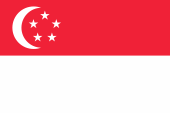 |
National- und Staatsflagge – national and state flag, Seitenverhältnis – ratio = 2:3, Quelle/Source, nach/by: Wikipedia (EN), Corel Draw 4   |
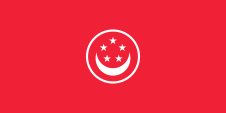 |
Handelsflagge – merchant flag, Seitenverhältnis – ratio = 1:2, Quelle/Source, nach/by: Flags of the World, Corel Draw 4 |
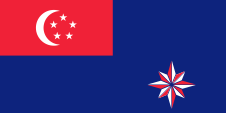 |
Staatsflagge zur See – state flag at sea, Seitenverhältnis – ratio = 1:2, Quelle/Source, nach/by: Flags of the World, Corel Draw 4 |
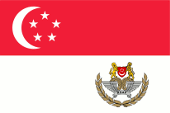 |
Flagge der Streitkräfte – flag of the Armed Forces, Seitenverhältnis – ratio = 2:3, Quelle/Source, nach/by: Wikipedia (EN) |
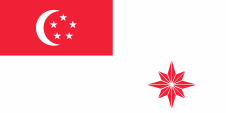 |
Marineflagge – naval flag, Seitenverhältnis – ratio = 1:2, Quelle/Source, nach/by: Flags of the World, Corel Draw 4 |
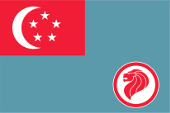 |
Flagge der Luftwaffe – flag of the Air Force, Seitenverhältnis – ratio = 2:3, Quelle/Source, nach/by: Wikipedia (EN) |
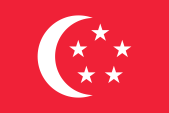 |
Präsidentenflagge – flag of the President, Seitenverhältnis – ratio = 2:3, Quelle/Source, nach/by: Flags of the World, Corel Draw 4 |
historische Flaggen – historical Flags: |
|
 |
bis/to 1818, Flagge des Sultanats Lingga – flag of the Sultanate of Lingga, Quelle/Source, nach/by: Die Welt im bunten Flaggenbild |
 |
1818–1824, Flagge des Sultanats Lingga – flag of the Sultanate of Lingga, Quelle/Source, nach/by: Die Welt im bunten Flaggenbild |
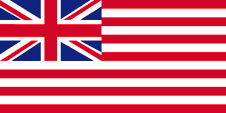 |
1824–1867, Flagge der Britischen Ostindienkompanie – flag of British East India Company, Seitenverhältnis – ratio = 1:2, Quelle/Source, nach/by: commons.wikimedia.org |
 |
1867–1963, Union Flag → quasi Nationalflagge, |
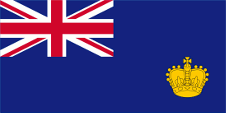 |
1868–1877, Straits Settlements, Flagge der Regierung (Staatsflagge) – flag of the government (state flag), Seitenverhältnis – ratio = 1:2, Quelle/Source, nach/by: Flags of the World   |
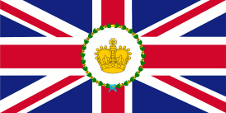 |
1868–1877, Straits Settlements, Flagge des Gouverneurs – flag of the Governor, Seitenverhältnis – ratio = 1:2, Quelle/Source, nach/by: Flags of the World |
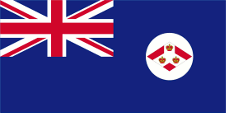 |
1879–1904, Straits Settlements, Flagge der Regierung (Staatsflagge) – flag of the government (state flag), Seitenverhältnis – ratio = 1:2, Quelle/Source, nach/by: Flags of the World   |
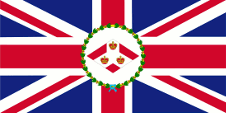 |
1879–1904, Straits Settlements, Flagge des Gouverneurs – flag of the Governor, Seitenverhältnis – ratio = 1:2, Quelle/Source, nach/by: Flags of the World |
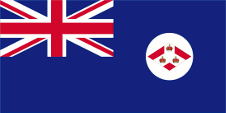 |
1904–1925, Straits Settlements, Flagge der Regierung (Staatsflagge) – flag of the government (state flag), Seitenverhältnis – ratio = 1:2, Quelle/Source, nach/by: Flags of the World   |
 |
1904–1942, Straits Settlements, Flagge des Gouverneurs – flag of the Governor, Seitenverhältnis – ratio = 1:2, Quelle/Source, nach/by: Flags of the World |
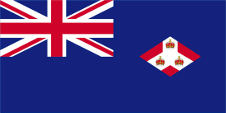 |
1925–1942, Straits Settlements, Flagge der Regierung (Staatsflagge) – flag of the government (state flag), Seitenverhältnis – ratio = 1:2, Quelle/Source, nach/by: Flags of the World   |
 |
1942–1945, Flagge Japans – flag of Japan, Seitenverhältnis – ratio = 7:10, Quelle/Source, nach/by: Wikipedia (EN) |
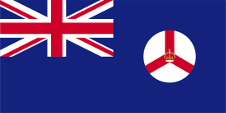 |
1946–1952, Singapore, Flagge der Regierung (Staatsflagge) – flag of the government (state flag), Seitenverhältnis – ratio = 1:2, Quelle/Source, nach/by: Flags of the World |
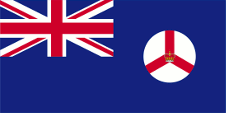 |
1952–1959, Singapore, Flagge der Regierung (Staatsflagge) – flag of the government (state flag), Seitenverhältnis – ratio = 1:2, Quelle/Source, nach/by: Flags of the World |
 |
1959–1963, Negara Singapura, Nationalflagge – national flag, Seitenverhältnis – ratio = 2:3, Quelle/Source, nach/by: Wikipedia (EN), Corel Draw 4   |
 |
1963–1965, Flagge der Föderation Malaysia – flag of the Federation of Malaysia, Seitenverhältnis – ratio = 1:2, Quelle/Source, nach/by: Flaggen und Wappen   |
| Die heutige Flagge Singapurs wurde am 03.12.1959 eingeführt, also ein paar Monate nachdem Großbritannien dem Staat Singapur volle Selbstverwaltung im Rahmen des Britischen Commonwealth of Nations gewährte. Sie zeigt zwei waagererechte Streifen in Rot und Weiß, sowie im roten Streifen nahe beim Mast einen weißen Halbmond und ein Kreis von fünf weißen fünfzackigen Sternen. | The today’s flag of Singapore was introduced on 3rd of December in 1959, well some month after United Kingdom granted the full self-government to the State of Singapur within the framework of the British Commonwealth of Nations. It shows two horizontal stripes in red and white, as well as a white half-moon and a circle of five white five-pointed stars in the red stripe near the pole. |
| Dieses Emblem hat nichts unmittelbar mit dem Islam zu tun, denn der Halbmond steht für den Aufstieg des Landes bzw. für das junge Alter der Nation. Die Sterne repräsentieren die fünf Ideale des Landes: Demokratie, Frieden, Fortschritt, Gerechtigkeit und Gleichheit. Rot steht für die Brüderlichkeit der Menschen in der ganzen Welt, Weiß für Tugend und Reinheit. Jedoch sind Rot und Weiß auch die traditionellen Farben der Malaien. |
That emblem has nothing to do directly with the Islam, because the half-moon
stands for the rise of the country respectively for the young age of the
nation. The stars represent the five ideals of the country: democracy,
peace, progress, justice and equality. Red stands for the brotherliness of the human beings in the whole world, white for virtue and purity, however red and white are also the traditional colours of the Malays. |
| Die Verwendung der Flagge war und ist äußerst strengen Regularien unterworfen, Verstöße dagegen werden rigoros geahndet und mit Geldstrafen belegt. Regierung auch Bevölkerung sind bemüht, diese Regeln zu überarbeiten, damit sich ein normales patriotische Verhältnis der Einwohner zu ihrer Flagge entwickeln kann. So wurden die äußerst strengen Regeln in den Jahren 2004 und 2006 überarbeitet und letztlich in einem neuen Gesetz umgesetzt, dem Gesetz über die nationalen Symbole (National Symbols Bill), das am 01.08.2023 in Kraft trat. Dort ist auch geregelt, dass der Rotton der Flagge als Pantone 032 wiederzugeben ist. |
The use of the flag was and is subject to extremely strict regulations,
violations of which are rigorously punished and fined. The government and the people are trying to revise these rules so that the inhabitants can develop a normal patriotic relationship with their flag. The extremely strict rules were revised in 2004 and 2006 and finally implemented in a new law, the National Symbols Bill, which came into force on 1st of August in 2023. This law also stipulates that the red colour of the flag must be Pantone 032. |
| Die Flagge des Präsidenten wurde ebenfalls 1959 eingeführt, damals jedoch (Singapur war noch keine Republik) für das Staatsoberhaupt den Yang di-Pertuan Negara. Sie wurde 1965 für den Präsidenten der Republik übernommen. Die Flagge zeigt das Bild des Wappenschildes des Landes, ist also einfarbig rot mit einen weißen Halbmond und ein Kreis von fünf weißen Sternen. Im Gegensatz zur Nationalflagge wurde ist Emblem auf dem Wappen um 90 Grad gedreht. | The flag of the president was also introduced in 1959, however at that time (Singapore was still none republic) for the chief of state, the Yang di-Pertuan Negara. It was taken over in 1965 for the president of the republic. The flag shows the drawing of the blazon of the country, is therefore single-coloured red with a white half-moon and a circle of five white five-pointed stars. In difference to the national flag the emblem on the coat of arms in turned in 90 degrees. |
| Die Handelsflagge wurde erst am 06.09.1966 eingeführt, und zwar um die Handelschiffe Singapurs besser von denen des benachbarten Indonesien unterscheiden zu können. Sie ist einfarbig rot mit dem Mond-Sterne-Emblen in weiß innerhalb eines weißen Ringes in der Mitte der Flagge. | The merchant flag was introduced not until the 6th of September in 1966, because to differentiate better the merchant ships of Singapore from those of the neighbouring Indonesia. It is single-coloured red with the moon-stars-emblen in white within a white ring in the middle of the flag. |
| Die wechselhafte Geschichte Singapurs kann sehr gut an den hier verwendeten Flaggen abgelesen werden: | The changeable history of Singapore is very good to see in the here used flags: |
| Im 18. Jahrhundert gehörte Singapur zum Sultanat Linga, und man wird hier die schwarze Flagge von Lingga verwendet haben, ab 1818 mit einer weißen Oberecke. | In the 18th century Singapore belonged to the Sultanate of Linga, and there will have been used the black flag of Lingga, since 1818 with a white upper staff quadrant. |
| Als Singapur im Jahre 1824 an die Britische Ostindienkompanie verkauft wurde, wurde hier deren Flagge bzw. der britische Union Jack verwendet. Die Flaggen der Ostindienkompanie zeigten seit Anfang des 17. Jahrhunderts weiße und rote Streifen, um deren Schiffe besser von anderen britischen Schiffen zu unterscheiden. | As Singapore was selled in 1824 to the die British East India Company, here was used its flag respectively the British Union Jack. The flags of the East India Company showed since the beginning of the 17th century white and red stripes, to differentiate better its ships from the other British ships. |
| Im Jahre 1867 wurden die Straits Settlements, zu denen Singapur gehörte, eine britische Kronkolonie. Für diese wurde eine Dienstflagge eingeführt, wie sie damals in britischen Kolonien üblich war. | In the year 1867 the Straits Settlements – to which Singapore belonged – became a British crown colony. For that was introduced an official flag how it was usual at that times for British colonies. |
Großbritannien hatte in Jahr 1864 ein Flaggensystem eingeführt, in dem:
Seit 1865 durften Schiffe von Kolonialregierungen einen Blue Ensign mit einem Badge (Abzeichen) im fliegenden Ende führen. |
United Kingdom introduced a flag system in 1864 in which:
Since 1865 ships of colonial governments were permitted to fly the Blue Ensign with a badge in the flying end of the flag. |
| Das Badge der Straits Settlements war ein roter Rhombus mit einer weißen Deichsel, auf die drei Kronen aufgelegt waren. Diese standen für die drei Besitzungen Pinang, Malakka und Singapur. | The badge of the Straits Settlements was a red rhombus with a white shaft on which were layed down three crowns. That stood for the three places of Penang, Malacca and Singapore. |
| An Land repräsentierten der einzelne Bürger und auch die Behörden ihren Status als Bürger oder Organe der britischen Nation, verkörpert im United Kingdom, durch die Verwendung des Union Jack, dann „Union Flag“ genannt. Zur See war somit für den britischen Bürger die britische Handelsflagge, der Red Ensign (Rote Flagge) vorgesehen. In einigen wenigen Fällen wurde den Bürgern einer Kolonie durch die Admiralität erlaubt, auf See einen Red Ensign mit dem Badge der Kolonie zu verwenden. |
On land, the individual
citizen and also the authorities represented their status as citizens or
organs of the British nation, embodied in the United Kingdom, through the
use of the Union Jack, then called the "Union Flag". At sea, the British citizen was thus provided with the British merchant flag, the Red Ensign. In a few cases, the citizens of a colony were allowed by the Admiralty to use their own Red Ensign with the colony's badge at sea. |
| In der Zeit der japanischen Besetzung (1942–1945) wurde die Flagge Japans verwendet. | In the times of the Japanese occupation (1942–1945) was used the flag of Japan. |
| Im Jahre 1946 wurde die Kolonie der Straits Settlements aufgelöst, und Singapur wurde eine eigene britische Kronkolonie. Als Dienstflagge wurde – wie bei britischen Kolonien üblich – weiterhin ein Blue Ensign verwendet, jedoch wurde ein eigenes, neues Badge entworfen. Es war eine weiße runde Scheibe mit einer roten Deichsel und einer britischen Krone darin. |
In the year 1946 the Colony of the Straits Settlements was dissolved and
Singapore became an own British crown colony. As official flag was now used – like it was usual in British colonies – a Blue Ensign, but it showed a new designed bagde in the flying end. It was a white round disk with a red shaft and a British crown in it. |
| Am 03.12.1959 wurde schließlich die heutige Flagge eingeführt und auch nach der Unabhängigkeit im Jahre 1963 weiter verwendet. Allerdings gehörte Singapur von 1963 bis 1965 zur Föderation Malaysia und es dominierte vorübergehend deren Flagge. | On 3rd of December in 1959 finally was introduced the today’s flag and also maintained after the independence in the year 1963. But Singapore belonged from 1963 to 1965 to the Federation of Malaysia and there dominated its flag in passing. |
| Quelle/Source: Die Welt der Flaggen, Flaggen und Wappen der Welt, Wikipedia (EN), Flags of the World, Flaggen Wappen Hymnen, Volker Preuß | |
Wappen – Coat of Arms: |
|
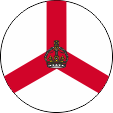 |
1946–1952, Emblem (Badge) der Straits Settlements – Badge of the Straits Settlements, Quelle/Source, nach by: Flags of the World, Wikipedia (D) |
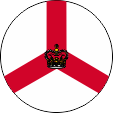 |
1952–1959, Emblem (Badge) der Straits Settlements – Badge of the Straits Settlements, Quelle/Source, nach by: Flags of the World, Wikipedia (D) |
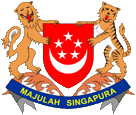 |
Wappen von Singapur – coat of arms of Singapore, Quelle/Source: Corel Draw 4 |
| Das Staatswappen wurde am 11.11.1959 eingeführt, also ein paar Monate nachdem Großbritannien dem Staat Singapur volle Selbstverwaltung im Rahmen des Britischen Commonwealth of Nations gewährte. Es zeigt einen einfarbig roten Wappenschild mit einem weißen Halbmond und ein Kreis von fünf weißen fünfzackigen Sternen. | The coat of arms was introduced on 11th of November in 1959, well some month after United Kingdom granted the full self-government to the State of Singapore within the framework of the British Commonwealth of Nations. It shows a single-coloured red blazon with a white half-moon and a circle of five white five-pointed stars. |
| Dieses Emblem hat nichts unmittelbar mit dem Islam zu tun, denn der Halbmond steht für den Aufstieg des Landes bzw. für das junge Alter der Nation. Die Sterne repräsentieren die fünf Ideale des Landes: Demokratie, Frieden, Fortschritt, Gerechtigkeit und Gleichheit. Rot steht für die Brüderlichkeit der Menschen in der ganzen Welt, Weiß für Tugend und Reinheit. Jedoch sind Rot und Weiß auch die traditionellen Farben der Malaien. | That
emblem has nothing to do directly with the Islam, because the half-moon
stands for the rise of the country respectively for the young age of the
nation. The stars represent the five ideals of the country: democracy,
peace, progress, justice and equality. Red stands for the brotherliness of the human beings in the whole world, white for virtue and purity, however red and white are also the traditional colours of the Malays. |
| Schildhalter sind ein Löwe und ein Tiger. Der Löwe steht für Singapur selbst, denn Singapur heißt "Löwenstadt". Der Tiger ist das Wappentier von Malaya, er erinnert an die frühere Verbindung mit Malaysia. Unterhalb des Wappens ein blaues Spruchband mit dem Wahlspruch "Majulah Singapura" → "Möge Singapur blühen". | Supporters of the shield are a lion and a tiger. The lion stands for Singapore itself, because Singapore means "lion's town". The tiger is the scutcheon animal of Malaya and he remembers the former connection with Malaysia. Below the scutcheon a blue banner with the motto "Majulah Singapura" → "May Singapore prosper". |
| Während der Zugehörigkeit Singapurs zur Föderation Malaysia blieb das Wappen – genauso wie die Flagge – unverändert. | During the affiliation of Singapore to the Federation of Malaysia the coat of arms remained unchanged, just as the flag. |
| Quelle/Source: Die Welt der Flaggen, Flaggen und Wappen der Welt, Flaggen Wappen Hymnen | |
Flugzeugkokarde – aircraft roundel: |
|
 |
1968–1973, Flugzeugkokarde – aircraft roundel Quelle/Source, nach by: Wikipedia (EN) |
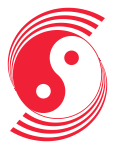 |
1973–1990, Flugzeugkokarde – aircraft roundel Quelle/Source, nach by: Wikipedia (EN) |
 |
seit/since 1990, Flugzeugkokarde – aircraft roundel Quelle/Source, nach by: Wikipedia (EN) |
Landkarten – Maps: |
Lage – Position: |
Landkarte des Landes – Map of the Country: |
| Malaysia und Singapur – Malaysia and Singapore: |
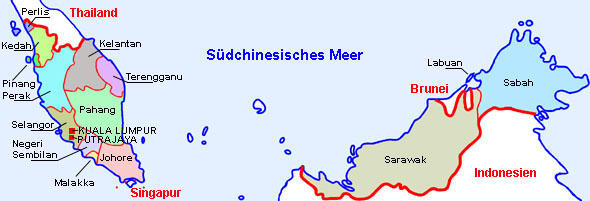 Landkarte/Map: Volker Preuß |
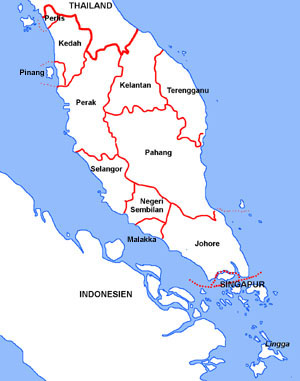 |
|
|
|
|
| Zahlen und Fakten – Numbers and Facts: | |
|
|
|
|
|
|
|
|
|
|
|
|
|
|
| 3.
Jahrhundert · erste Erwähnung einer Siedlung namens Pu Luo Chung an der
Stelle des heutigen Singapur 7. Jahrhundert · Beginn der Besiedlung durch hinduistische Malaien aus dem Königreichs Shrividjaja (im heutigen Indonesien) 1160 · Gründung der Stadt Temasek durch hinduistische Malaien an der Stelle des heutigen Singapur 1299 · ein Prinz aus Madjapahid (im heutigen Indonesien) gibt der Siedlung Temasek den Namen Singapura (Löwenstadt) 1377 · Truppen aus Madjapahid zerstören die Stadt 15.–18. Jahrhundert · Singapur wird in Kämpfe zwischen Siam (heutiges Thailand) und dem Reich Madjapahid hineingezogen, die bedeutungslose Stadt wird von Händlern, Piraten und Sultanen beherrscht, zuletzt gehörte die Stadt zum Sultanat Lingga 1819 · Sir Stamford Raffles von der Britischen Ostindienkompanie (East India Company) errichtet auf der Insel Singapur eine Handelsniederlassung 03.08.1824 · Sir Stamford Raffles und John Crawfurd erwerben die Insel Singapur vom Sultan von Lingga für die Britische Ostindienkompanie 14.08.1826 · Singapur wird mit Pinang und Malakka zur Kolonie "Straits Settlements" unter der Oberhoheit der Britischen Ostindienkompanie zusammengeschlossen 1832 · der Verwaltungssitz der Straits Settlements wird von Pinang nach Singapur verlegt 1858 · die Verwaltung der Straits Settlements geht auf Britisch-Indien über 01.04.1867 · die Straits Settlements werden britische Kronkolonie 15.02.1942 · Singapur wird im Zweiten Weltkrieg durch japanische Truppen erobert 12.09.1945 · Kapitulation der japanischen Truppen, Rückkehr der Briten, Britische Militärverwaltung 01.04.1946 · das Ende der Straits Settlements: Pinang und Malakka werden der Malaiischen Union (Malaya) angeschlossen, Singapur wird jedoch eine eigene britische Kronkolonie 1948 · Ausnahmezustand 1951 · städtische Selbstverwaltung 1955 · Großbritannien gewährt eingeschränkte Selbstverwaltung Mai 1959 · erste Parlamentswahlen, neue Verfassung 03.06.1959 · Großbritannien gewährt dem "Staat Singapur" volle Selbstverwaltung im Rahmen des Britischen Commonwealth of Nations 1962 · Volksabstimmung, Mehrheit für einen Anschluss an die künftige Föderation Malaysia 31.08.1963 · Großbritannien gewährt Singapur die Unabhängigkeit 16.09.1963 · Singapur schließt sich mit Malaya, Sarawak und Sabah zur Föderation Malaysia zusammen, die Föderation Malaysia betreibt eine stark malaiisch-nationalistische Politik, was zu Problemen mit der chinesisch dominierten Stadt Singapur führt 1964 · Unruhen 1965 · Unruhen 09.08.1965 · Singapur verlässt die Föderation Malaysia 21.09.1965 · Singapur wird Mitglied der UNO 22.12.1965 · neue Verfassung als "Republik Singapur" 1995 · Spannungen und Differenzen mit den Philippinen 1998 · Spannungen und Differenzen mit Malaysia |
| 3rd
century · first mention of a settlement named Pu Luo Chung at the place of
the today’s Singapore 7th century · onset of the settlement by Hindu Malays from the Kingdom of Shrividjaja (in the today’s Indonesia) 1160 · foundation of the town of Temasek by Hindu Malays at the place of the today’s Singapore 1299 · a prince from Madjapahid (in the today’s Indonesia) gives the place of Temasek the name Singapura (lion's town) 1377 · troops from Madjapahid destroy the town 15th–18th century · Singapore becomes embroiled in the struggles between Siam (today’s Thailand) and the Empire of Madjapahid, the insignificant town is ruled by merchants, pirates and sultans, finally the town belonged to the Sultanate of Lingga 1819 · Sir Stamford Raffles from the British East India Company establishes on Singapore Island an agency 3rd of August 1824 · Sir Stamford Raffles and John Crawfurd purchase Singapore Island from the Sultan of Lingga for the British East India Company 14th of August 1826 · Singapore becomes joined with Penang and Malacca to the colony of the "Straits Settlements" under the supremacy of the British East India Company 1832 · the seat of government of the Straits Settlements becomes transfered from Penang to Singapore 1858 · the administration of the Straits Settlements becomes handed over to British India 1st of April 1867 · the Straits Settlements become a British crown colony 15th of February 1942 · Singapore becomes conquered by Japanese troops in the Second World War 12th of September 1945 · capitulation of the Japanese troops, return of the British, British military government 1st of April 1946 · the end of the Straits Settlements: Penang and Malacca become affiliated to the Malay Union (Malaya), but Singapore becomes an own British crown colony 1948 · state of emergency 1951 · municipal self administration 1955 · United Kingdom grants limited self government May 1959 · first elections for parliament, new constitution 3rd of June 1959 · United Kingdom grants the "State of Singapore" full self government within the framework of the British Commonwealth of Nations 1962 · plebiscite, majority for an union with the coming Federation of Malaysia 31st of August 1963 · United Kingdom grants Singapore the independence 16th of September 1963 · Singapore joines with Malaya, Sarawak and Sabah to the Federation of Malaysia, the Federation of Malaysia powers strong malaysian-nationalist politics and there arised problems with the by Chinese predominated City of Singapore 1964 · riots 1965 · riots 9th of August 1965 · Singapore leaves the Federation of Malaysia 21st of September 1965 · Singapore becomes member in the UNO 22nd of December 1965 · new constitution as "Republic of Singapore" 1995 · excitements and differences with the Philippines 1998 · excitements and differences with Malaysia |
| Quelle/Source: Atlas zur Geschichte, Wikipedia (EN), World Statesmen |
| Der Name "Singapur" war der Stadt Temasek im Jahre 1299 von einem Prinzen aus dem Reich Madjapahid im heutigen Indonesien verliehen vorden. Das Wort "Singapur" enthält die beiden Sanskrit-Worte "Simha" und "Pur", Singapur ist die "Löwenstadt". | The name "Singapore" was awarded to the town Temasek in the year 1299 by a prince from the Empire of Madjapahid in the today’s Indonesia. The word "Singapur" contains the both Sanskrit words "Simha" and "Pur", Singapore is the "Lion's Town". |
| Quelle/Source: Atlas der wahren Namen | |